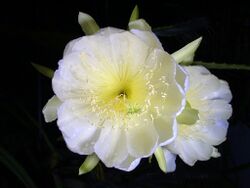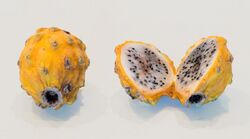Biology:Hylocereus megalanthus
| Yellow pitahaya | |
|---|---|

| |

| |
| Scientific classification | |
| Kingdom: | Plantae |
| Clade: | Tracheophytes |
| Clade: | Angiosperms |
| Clade: | Eudicots |
| Order: | Caryophyllales |
| Family: | Cactaceae |
| Subfamily: | Cactoideae |
| Genus: | Hylocereus |
| Species: | H. megalanthus
|
| Binomial name | |
| Hylocereus megalanthus (K. Schumann ex Vaupel) Ralf Bauer
| |
| Synonyms | |
|
Cereus megalanthus K. Schumann ex Vaupel | |
Hylocereus megalanthus is a cactus species in the genus Hylocereus that is native to northern South America, where it is known, along with its fruit, by the name of Pitahaya. The species is grown commercially for its yellow fruit, but is also an impressive ornamental climbing vine with perhaps the largest flowers of all cacti.
The yellow fruit has thorns, unlike the red dragon fruits (H. undatus, H. polyrhizus, H. costaricensis), and is commonly known as "yellow dragon fruit", "yellow pitahaya" or "yellow pitaya".
Etymology
Megalanthus (Greek) - large flowered. This species produces among of the largest flowers within the cactus family.
Origin and habitat
Venezuela to Peru, including Colombia, Bolivia, Ecuador, in tropical riparian forests. It is Epiphytic or xerophytic.
Description
- Stems may lie along the ground (procumbent), climb (scandent), or hang (pendent). Stems are often only 1.5 cm thick, producing aerial roots; 3 ribs; margins slightly undulating; white areoles; 1-3 spines 2–3 mm long, yellowish; several hairs on young growth, brittle-like; green epidermis.
- Flowers are nocturnal and funnel-shaped, 32–38 cm long; pericarpel is ovoid or slightly globose, tubercles are large and flattened, with felt-like and spiny areoles subtended by small bracteoles; receptacle elongate; outer tepals long, green, triangular-acute; inner tepals 10 cm long, 3.5 cm wide, white, broader; stamens numerous inserted in two zones, yellow; style yellow, stigma lobes numerous, green.
- Fruit: ovoid, tuberculate, spiny, skin yellow (sometimes red/orange, when hybridized), seeds black; interior white (sometimes pink, when hybridized), edible, having a pleasant, mildly sweet flavor.
- Pollination: Yellow pitayas are self-fertile (meaning no cross-pollination is required)[1][2]
Systematics
This species is closely related to Hylocereus setaceus (floral tube or pericarpel 19–22 cm with small tubercles) but otherwise quite isolated within Hylocereus. It is intermediate between Selenicereus and Hylocereus. Recent research suggest that this species originated as a hybrid between species of Hylocereus and Selenicereus (see references[which?]). The two species possibly involved, as being native in the same area, are Hylocereus costaricensis and Selenicereus inermis.
Cultivation
An easily cultivated, fast growing plant. Needs a compost containing plenty of humus and sufficient moisture in summer. Should not be kept under 8 °C (46.5 °F) in winter. Can be grown in semi-shade, but best in full sunlight. Extra light in the early spring will stimulate budding. Flowers in June to October. This plant may grow to a very large size.
See also
- Pitahaya
- List of culinary fruits
References
- ↑ "Ayuda para polinizar mi pitahaya para obtener frutos". http://www.infojardin.com/foro/showpost.php?p=2507245&postcount=8. Retrieved 23 December 2017.
- ↑ "How to get Your Dragon Fruit Cactus to Fruit". 30 July 2013. http://tastylandscape.com/2013/07/30/how-to-get-dragon-fruit-cactus-to-fruit/. Retrieved 23 December 2017.
- Anderson, E. F. (2001). The Cactus Family. Timber Press ISBN:0-88192-498-9
- Bauer, R. (2003) A synopsis of the tribe Hylocereeae F. Buxb. Cactaceae Syst. Init. 17: 3-63.
- Tel-Zur N, Abbo S, Bar-Zvi D, Mizrahi Y. (2004 ) Genetic relationships among Hylocereus and Selenicereus vine cacti (Cactaceae): evidence from hybridization and cytological studies. Ann Bot (Lond) 94(4):527-34.
Wikidata ☰ Q13572894 entry


